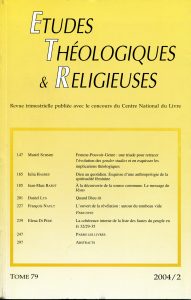Au mythe religieux d’une présence agissante de Dieu, le récit chrétien oppose, non pas l’absence d’un Dieu qui aurait déserté l’histoire humaine, mais un entre-deux qui interdit toute saisie de la figure divine et l’engage plutôt dans un procès infini de signifiance. François Nault relit ici l’épisode du tombeau vide en quête de quelques repères pour l’analyse de cette logique structurelle de l’entre-deux et du signifiant. Il y est question en effet de la disparition d’un corps, donc de la présence d’un vide, mais aussi d’un quelque-chose-rendu-possible-par-le-vide ; car le tombeau n’est pas seulement vide, il est ouvert. Et sur quoi ouvre-t-il si ce n’est sur sa propre venue au langage dans « le récit du tombeau vide » et dans les multiples lectures qu’il autorise ?
Je tiens à remercier Patrice Bergeron pour l’aide apportée à la recherche documentaire qui est à la base de ce texte.
The openness of revelation : around the empty tomb
Over against the religious myth of God as a present agency in the world, the Christian message does not proclaim a God having deserted human history, but rather a kind of in-between which does not allow the figure of the Divine to be grasped, therefore leading to an endless process of « signifiance ». François Nault rereads the empty tomb episode looking for markers in order to analyse the logic which structures the in-between and the signifier. The episode tells about the disappearance of a body consequently giving place to a void, but at the same time to something-made-possible-by-the-void. Besides being empty, the tomb is open. What can it be open for, apart from its own transformation into the words of the Œstory of the empty tomb’ and the various and numerous readings which are then made possible ?
p. 227-237
Auteur
NAULT François
François NAULT est professeur de théologie fondamentale à la Faculté de théologie et de sciences religieuses de l'université Laval (Québec).
